Abstract
In the framework of the comprehensive research of Far Eastern natural populations of soybean nodule bacteria, laboratory experiments have been conducted at the All-Russia Scientific Research Institute of Soybean (Blagoveshchensk) with the purpose to identify distinctive features of rhizobia species Sinorhizobium fredii (Scholla and Elkan, 1984) and Bradyrhizobium japonicum (Jordan, 1982) whose pure cultures were isolated from soils of Far Eastern regions practicing soybean cultivation. It is established that B. japonicum strains start growing in Petri dishes on the seventh to tenth and even on the 20th day after the inoculation, assimilate a limited number of carbon nutrition sources, release mostly alkaline metabolic products, and feature a relatively low osmotic resistance. Representatives of this species are susceptible to extreme environmental conditions; their growth sharply slows down on acidic and alkaline nutrient media and stops at high (37–42°C) temperatures. However, under the optimal conditions, this rhizobia species dominates in the nodulation of soybean plants due to its high and persistent virulence. The restriction analysis of the studied B. japonicum strains confirmed their identity. S. fredii strains start growing in Petri dishes on the second to fourth day after the inoculation, assimilate well a broad spectrum of carbon nutrition sources, and release acidic metabolic products. Most strains of this species feature high osmotic resistance. Cultures retaining universal growth capacity under extreme environmental conditions (high temperatures and low and high pH values) have been identified in the group of S. fredii strains. This rhizobia species can predominate in the formation of symbiotic mechanisms in years featuring extreme weather conditions. Enzymatic fermentation of gene 16S rRNA in the studied S. fredii strains was performed using restriction enzyme HaeIII; the analysis of the fermentation results confirmed the identity of these strains. The RAPD-PCR analysis has demonstrated the intraspecific specificity of the studied B. japonicum and S. fredii strains: these species feature high degrees of polymorphism reflecting their population heterogeneity.




Similar content being viewed by others
REFERENCES
Dorosinskii, L.M., Kluben’kovye bakterii i nitragin (Nodule Bacteria and Nitragin), Leningrad: Kolos, 1970.
Mishustin, E.N. and Shil’nikova, V.K., Kluben’kovye bakterii i inokulyatsionnyi protsess (Nodule Bacteria and the Inoculation Process), Moscow: Nauka, 1973.
Til'ba, V.A., Begun, S.A., and Yakimenko, M.V., Natural populations of soybean rhizobia and their use in soybean agrocenoses, in Innovatsionnaya deyatel’nost' agrarnoi nauki v Dal’nevostochnom regione: Sb. nauch. tr. (Innovative Activity of Agrarian Science in the Far East Region: Scientific Proceedings), Vladivostok: Dal’nauka, 2011.
Baimiev, An.Kh., Gumenko, R.S., Matniyazov, R.T., Chubukova, O.V., and Baimiev, Al.Kh., The modern taxonomy of nodule bacteria, Biomika, 2013, vol. 5, nos. 3-4, pp. 136–157.
Shamseldin, A., Abdelkhalek, A., and Sadowsky, M.J., Recent changes to the classification of symbiotic, nitrogen-fixing, legume-associating bacteria: A review, Symbiosis, 2017, vol. 71, pp. 91–109.
Begun, S.A. and Til’ba, V.A., Rapidly growing forms of soybean nodule bacteria in the soils of the Amur Region, Byull. VIR (St. Petersburg), 1992, no. 220, pp. 78–85.
Akimova, E.S., Gumenko, R.S., Vershinina, Z.R., Baimiev, Al.Kh., and Baimiev, An.Kh., Markers for the search for nodule bacteria based on symbiotic genes, Mikrobiologiya, 2017, vol. 86, no. 5, pp. 621–628.
Frugoli, J., Dickstein, R., Udvardi, M.K., Roy, S., Liu, W., Sekhar, Nandety, R., Crook, A., Mysore, K.S., and Pislariu, C.I., Celebrating 20 years of genetic discoveries in legume nodulation and symbiotic nitrogen fixation, Plant Cell, 2020, vol. 32, pp. 15–41.
Scholla, M. and Elkan, G.H., Rhizobium fredii sp. nov., a fastgrowing species that effectively nodylates soybeans, Int. J. Syst. Bacteriol., 1984, vol. 34, no. 4, pp. 484–486.
Jordan, D.C., Transfer of Rhizobium japonicum, Buchanan 1980 to Bradyrhizobium gen. nov., a genus of slow grawing root nodule bacteria of leguminous plants, Int. J. Syst. Bacteriol., 1982, vol. 32, no. 1, pp. 136–139.
Yakimenko, M.V. and Begun, S.A., Major directions of research of natural populations of rhizobia in the Far East, Vestn. Dal’nevost. Otd. Ross. Akad. Nauk, 2016, no. 2, pp. 45–49.
Lavrenchuk, L.S. and Ermoshin, A.A., Mikrobiologiya: Praktikum (Microbiology: Manual), Yekaterinburg: Ural. Univ., 2019.
Praktikum po mikrobiologii (Manual on Microbiology), Shil’nikova, V.A., Ed., Moscow: Drofa, 2004.
Klenova, N.A., Laboratornyi praktikum po mikrobiologii: Uchebnoe posobie (Laboratory Manual on Microbiology: Handbook), Samara: Samar. Univ., 2012.
Begun, S.A., Sposoby, priemy izucheniya i otbora effektivnykh shtammov kluben’kovykh bakterii soi. Metody analiticheskoi selektsii (Methods and Techniques for Studying and Selecting Effective Strains of Soybean Nodule Bacteria. Analytical Selection Methods), Blagoveshchensk: Zeya, 2005.
Ausubel, F.H., Brent, R., Kingston, R.E., Moore, D.D., Seidman, J.G., Smith, J.A., and Struhl, K., Current Protocols in Molecular Biology, John Wiley and Sons, 1994.
Petrov, D.G., Makarova, E.D., Germash, N.N., and Antifeev, I.E., Methods for isolation and purification of DNA from cell lysates (review), Nauchn. Priborostr., 2019, vol. 29, no. 4, pp. 28–50.
Versalovic, J., Schneider, M., Bruijn, F.J., and Lupski, J.R., Genomic fingerprinting of bacteria using repetitive sequence-based polymerase chain reaction, Meth. Cell. Mol. Biol., 1994, no. 5, pp. 25–40.
Lane, D.E., 16S/23S rRNA sequencing, in Nucleic Acid Techniques in Bacterial Systematics, Stacebrandt, E. and Goodfellow, M., Eds., New York: Wiley, 1991, pp. 115–147.
Sambruk, J., Frisch, E.F., and Maniatis, T., Molecuar Cloning: A Laboratory Manual, New York: Cold Spring Harbor, 1989.
Savelkoul, P.H., Aarts, H.J., J. de Haas, Dijkshoorn, L., Duim, B., Otsen, M., Rademaker, J.L., Schouls, L., and Lenstra, J.A., Amplified-fragment length polymorphism analysis: The state of an art, J. Clin. Microbiol., 1999, no. 37, pp. 3083–3091.
Torriani, S., Use of PCR-based methods for rapid differentiation of Lactobacillus delbrueckii subsp. bulgaricus and L. delbrueckii subsp. lactis, J. Appl. Environ. Microb., 1999, vol. 65, no. 10, pp. 4351–4356.
Author information
Authors and Affiliations
Corresponding author
Ethics declarations
The authors declare that they have no conflict of interest. This article does not contain any studies involving animals or human participants performed by any of the authors.
Additional information
Translated by L. Emeliyanov
About this article
Cite this article
Yakimenko, M.V., Begun, S.A. Distinctive Features of Rhizobia Species Sinorhizobium fredii and Bradyrhizobium japonicum Inhabiting Soils of the Russian Far East. Russ. Agricult. Sci. 47, 58–62 (2021). https://doi.org/10.3103/S1068367421010201
Received:
Revised:
Accepted:
Published:
Issue Date:
DOI: https://doi.org/10.3103/S1068367421010201




